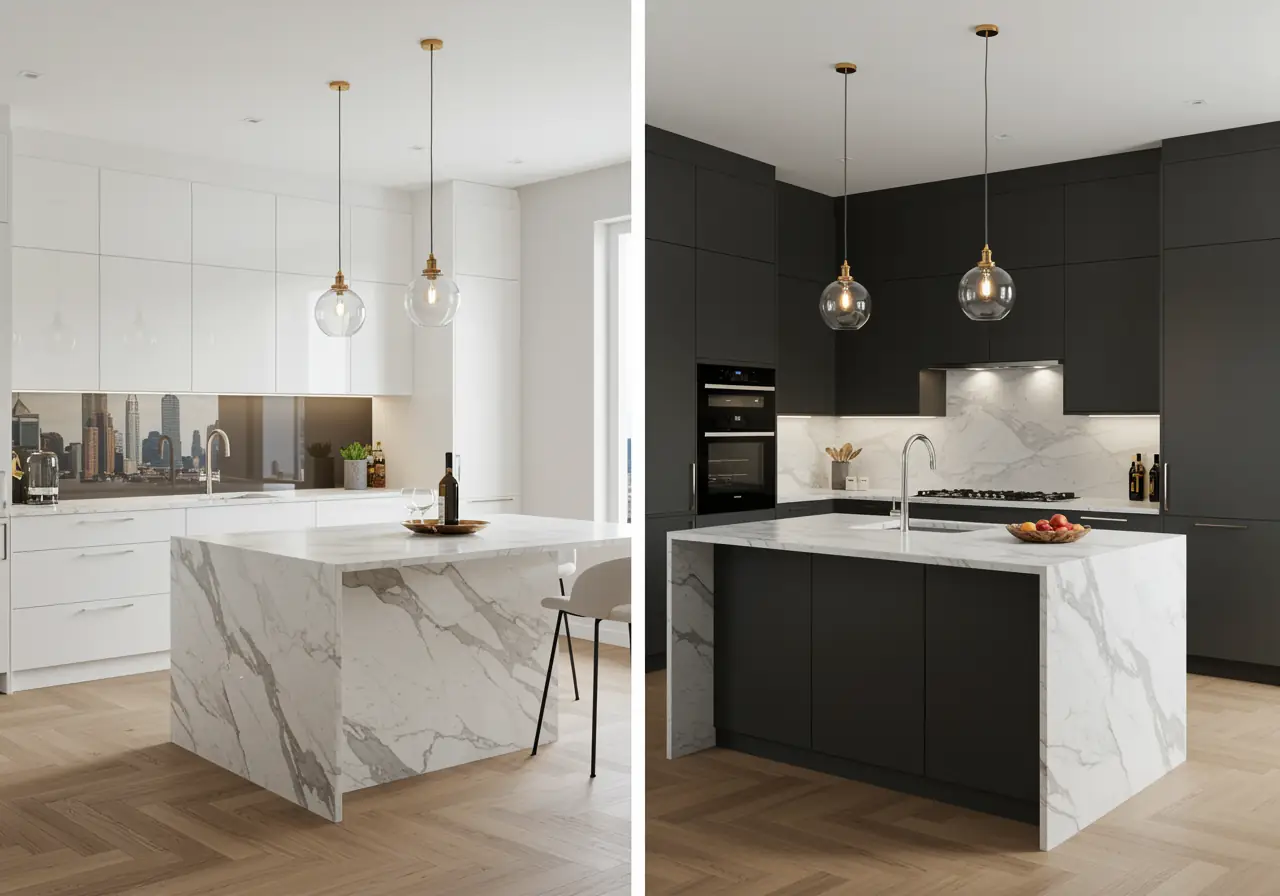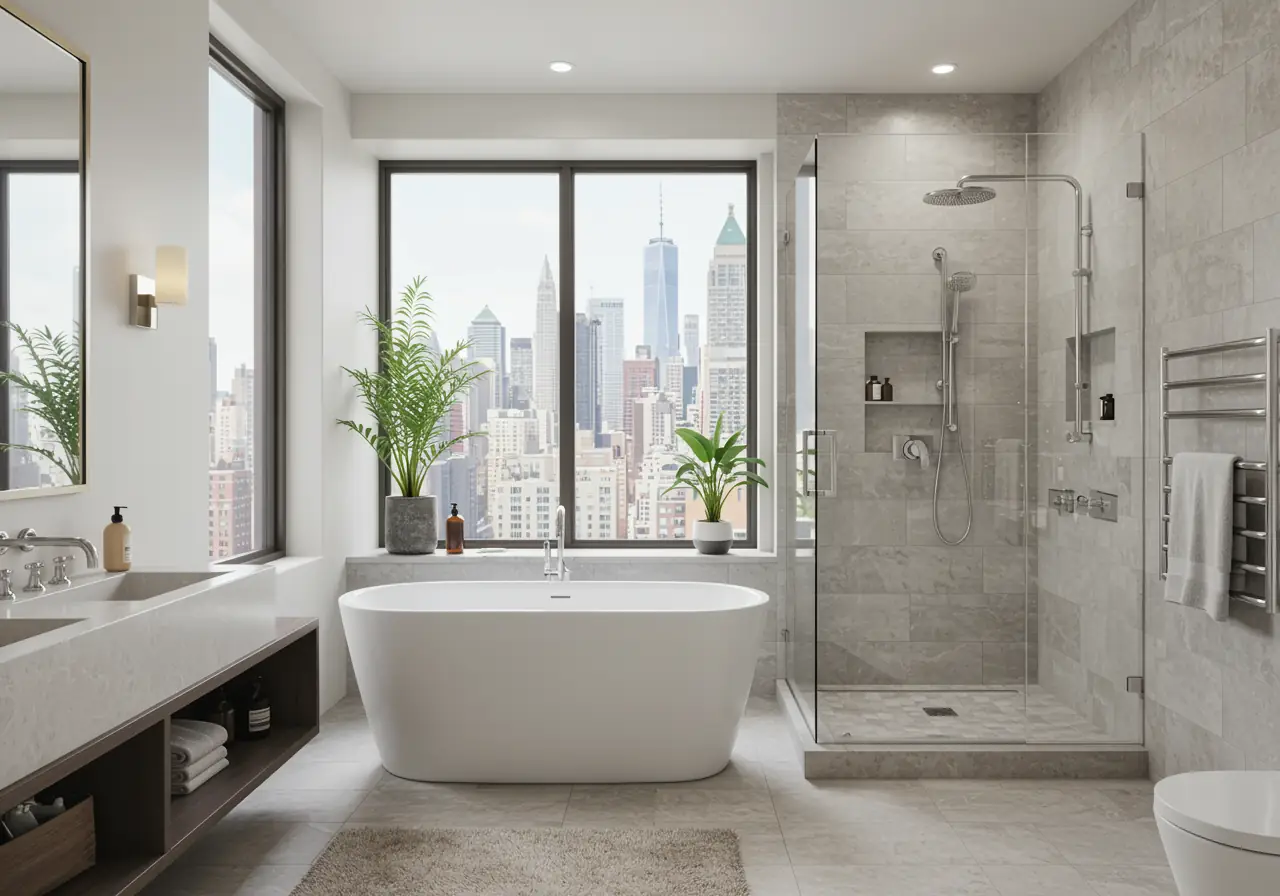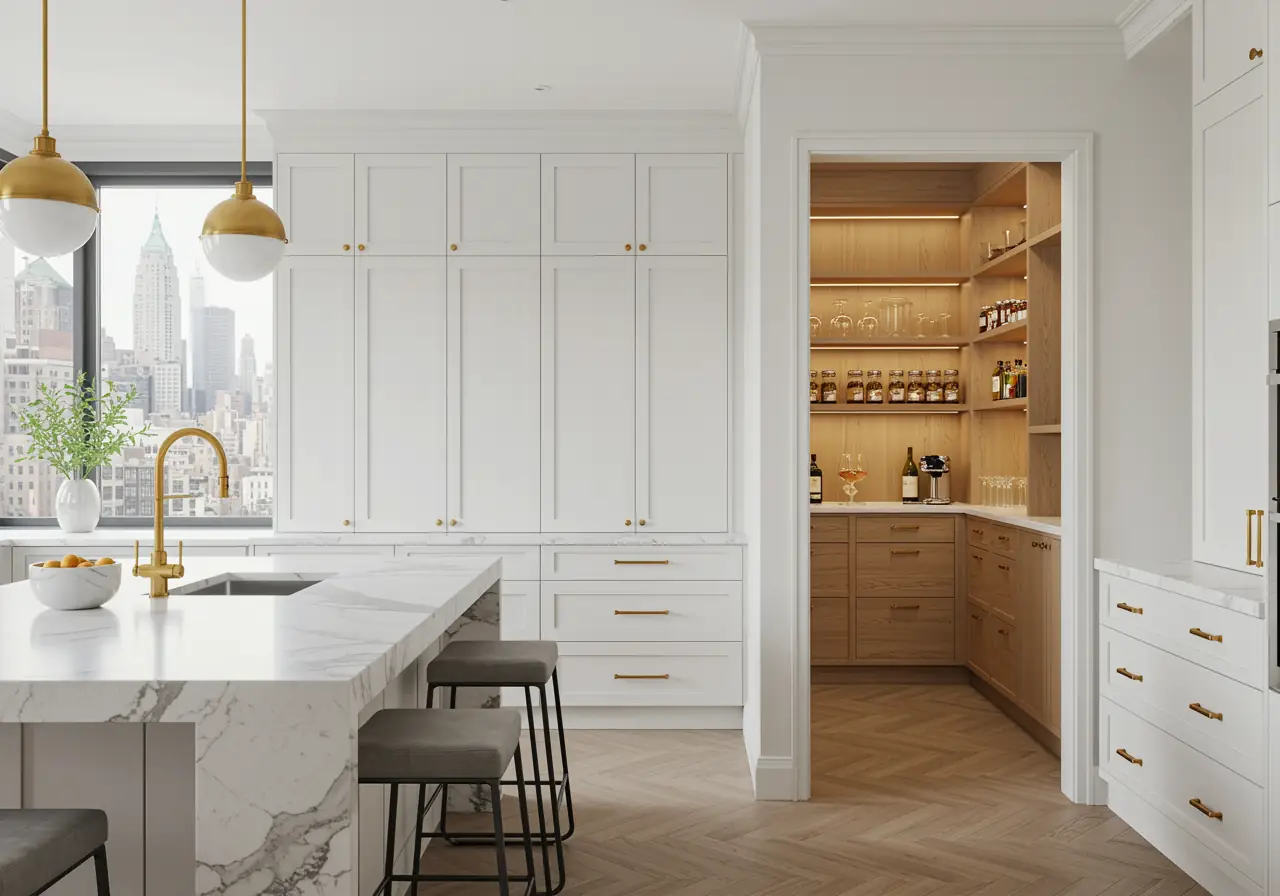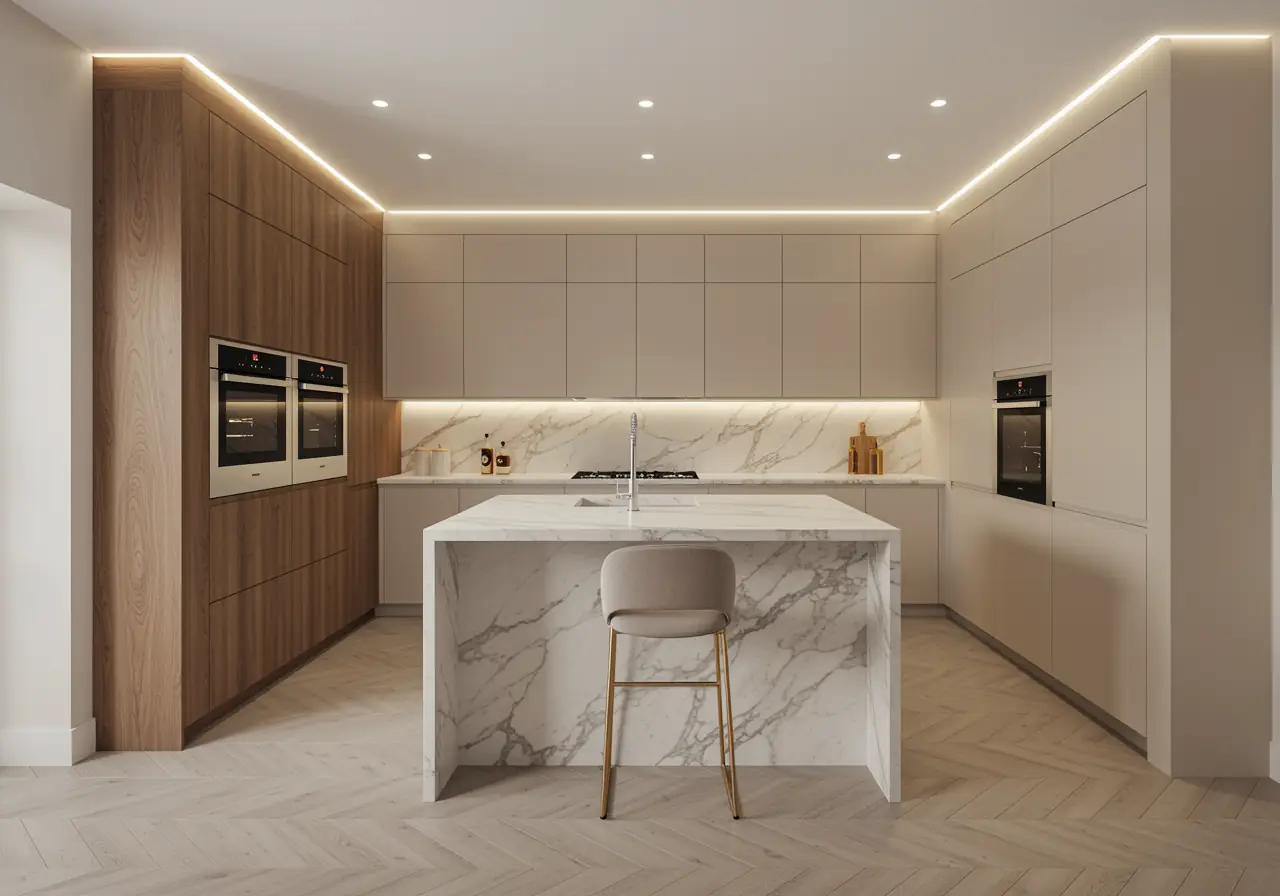Manhattan Galley Kitchen Magic: From Cramped to Luxurious
In this guide, we reveal how to transform a Manhattan galley kitchen from a cramped, narrow space into a luxurious and highly functional culinary haven. Inspired by the efficient layouts of ships, trains, and planes, galley kitchens feature parallel cabinetry and a central walkway - common in historic Manhattan apartments and older city buildings. With the right design, these compact kitchens can maximize space, style, and home value. In this guide, you’ll discover optimal galley kitchen layouts, premium materials, and smart storage solutions that bring both elegance and efficiency to your space.
We’ll cover everything from layout planning and luxury finishes to renovation costs, timelines, and practical considerations. Whether you’re planning a full galley kitchen remodel or targeted upgrades, this guide will provide the inspiration and expert advice you need to create a Manhattan galley kitchen that’s visually stunning, space-savvy, and perfect for cooking, entertaining, and everyday living.
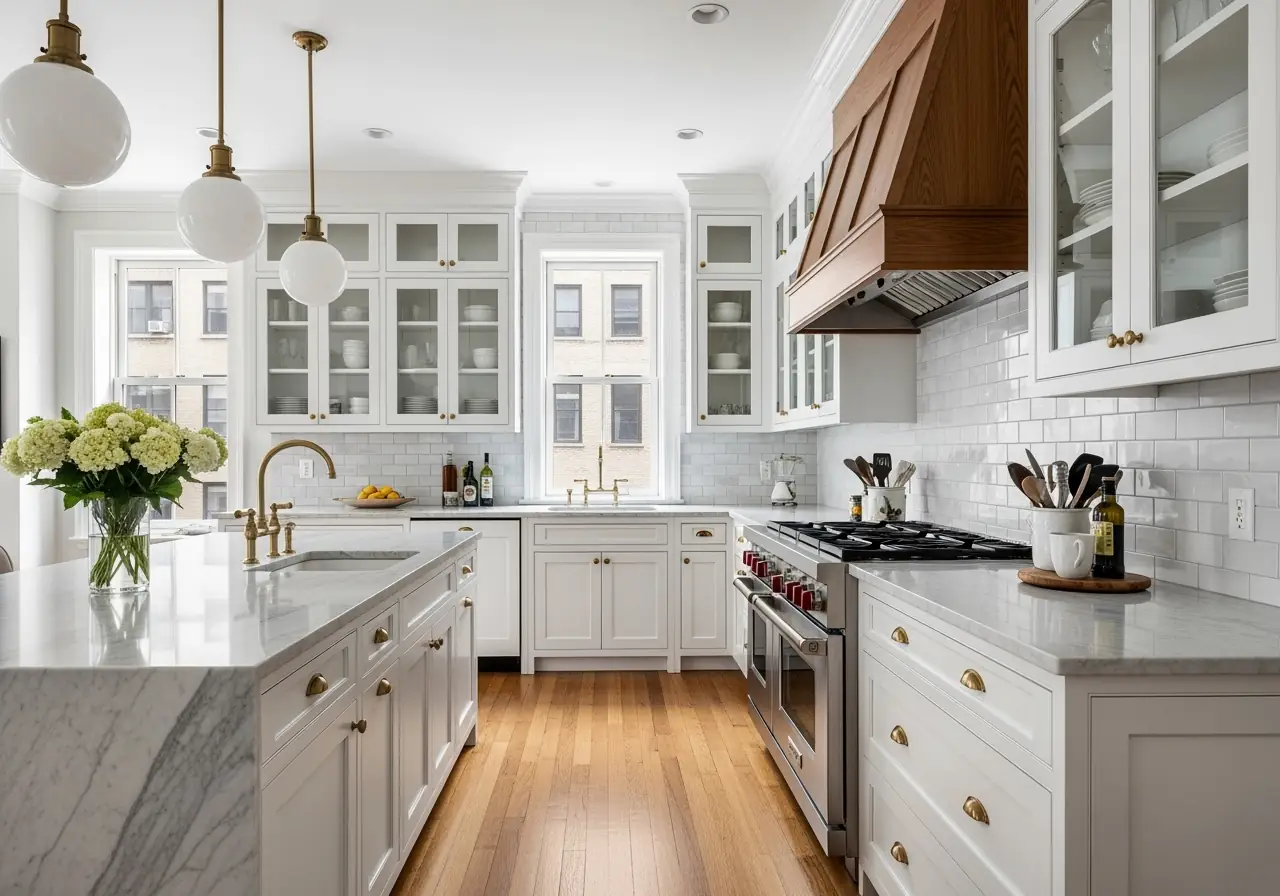
What is a galley kitchen and why it works in NYC
The term "galley kitchen" originated from the compact cooking spaces found on ships, where efficiency and space utilization were paramount concerns. Essentially, a kitchen galley features two parallel walls lined with countertops, cabinets, and appliances, creating an elongated working space with a central aisle. The design traces its roots to sailing vessels, where the efficient layout minimized crew movement while swaying at sea.

Definition and origin of galley kitchens
Historically, the first mass-produced galley kitchen layout was known as the Frankfurt kitchen, designed by Margarete Schütte-Lihotzky in 1926 for a housing estate in Germany. This groundbreaking design saw over 10,000 units installed, becoming the most influential kitchen of that period. The concept later gained popularity in residential settings, especially after World War II, when efficient, cost-effective designs were needed for mass housing.
A galley kitchen typically follows the principles of the 'kitchen triangle,' placing the sink, stove, and refrigerator positioned for optimal workflow. The layout comes in two variations: a closed-end design (with a wall at one end) or a pass-through configuration allowing traffic flow from both ends.
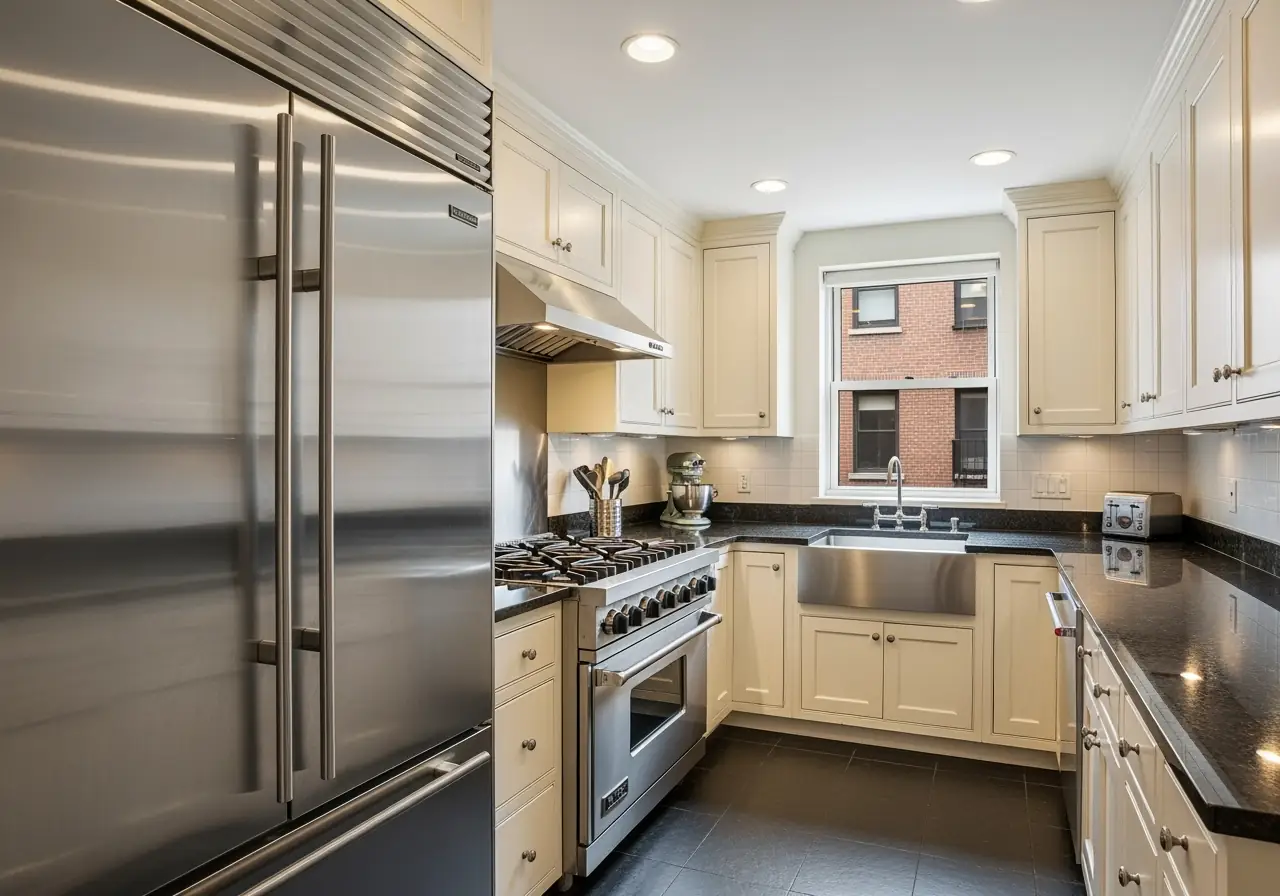
Why galley kitchens are common in Manhattan apartments
In space-constrained Manhattan, galley kitchens offer an ideal solution for apartment living. Their narrow, efficient design maximizes limited square footage - perfect for New York City's typically compact floor plans. The layout makes efficient use of vertical space with hanging pots, dish racks, and ceiling-hung cabinets, providing excellent kitchen storage options.
Furthermore, galley kitchens help separate cooking areas from living spaces in small apartments, containing cooking messes and odors to one area - a valuable feature in compact Manhattan homes where living areas often serve multiple purposes.
Pros and cons of galley kitchen layouts
Pros:
- Exceptional efficiency with all workspaces within easy reach
- Maximizes storage in limited space
- Lower renovation costs due to smaller footprint
- Creates a streamlined workflow with minimal movement
- Offers privacy, keeping kitchen messes out of sight
Cons:
- Limited space for multiple cooks - challenging for those who cook together
- Can feel cramped, especially with insufficient aisle width
- Restricted counter and storage space compared to larger layouts
- Potential for limited natural light
- Not ideal for entertaining, as there's typically no space for dining
For optimal functionality, experts recommend an aisle width of 4 to 6 feet between counters, ensuring comfortable movement without wasted space. This careful balance between efficiency and comfort makes galley kitchens particularly suitable for Manhattan's space challenges.
Turn your Manhattan galley kitchen into a luxury space that maximizes style and function - partner with KS Renovation Group for expert design and flawless execution.
Designing for flow: ideal layout and aisle width
Creating an efficient flow in your Manhattan galley kitchen begins with understanding the fundamental design principles that maximize functionality in narrow spaces. The layout's success hinges on strategic placement of key elements and proper spacing.
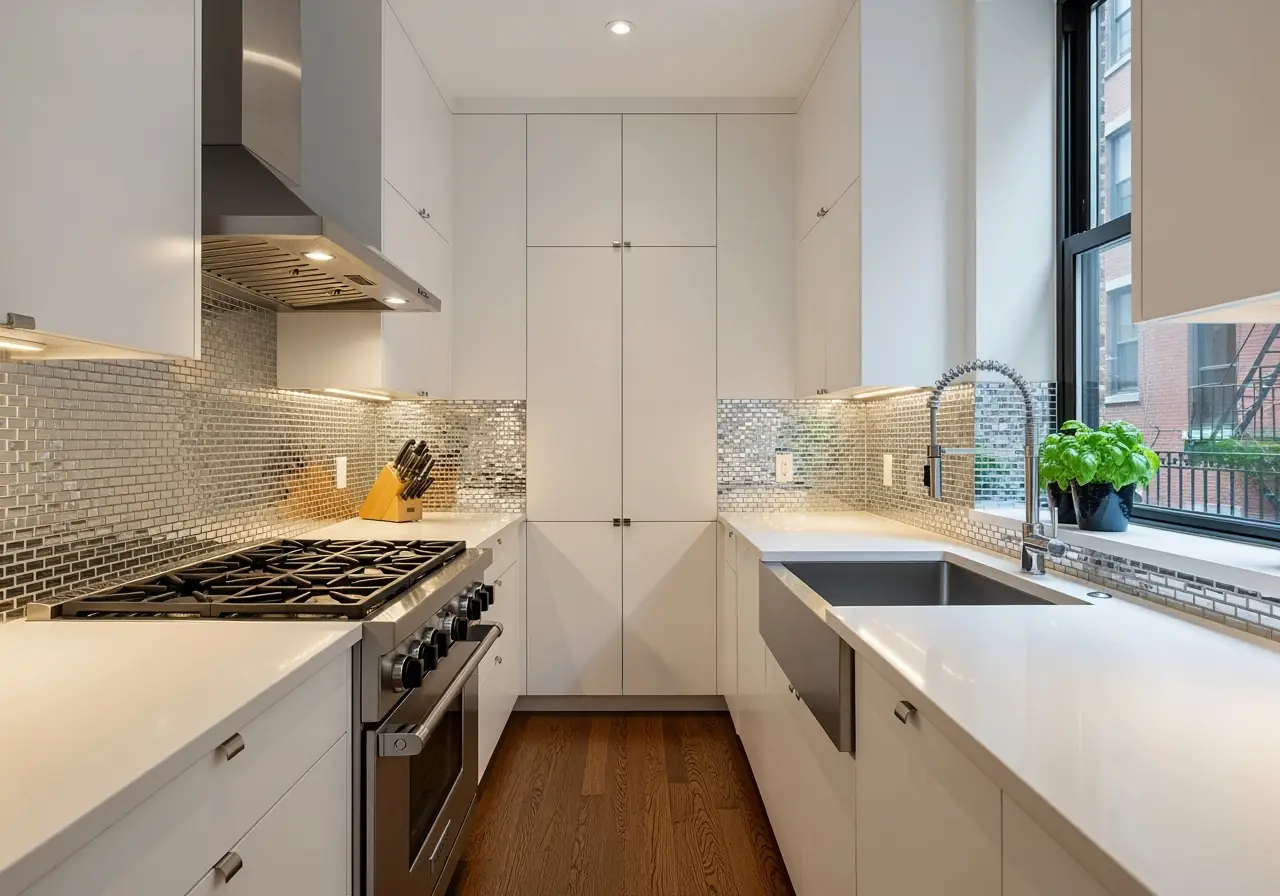
Understanding the work triangle in galley kitchens
The work triangle concept forms the backbone of efficient galley kitchen design. This principle involves positioning the refrigerator, stove, and sink in a triangular formation to create a streamlined workflow. In a traditional two-wall galley kitchen, experts recommend placing the refrigerator at one end, the stove at the other, and the sink in the middle on the opposite wall to optimize movement. This arrangement minimizes unnecessary steps between cooking stations.
For optimal efficiency, the total distance between these three points should measure between 13 and 26 feet. Professional designers often suggest maintaining at least 3 feet between the stove and sink for adequate preparation space. Additionally, positioning the stove near the serving area and the refrigerator close to the sink creates a more seamless transition between collecting, preparing, cooking, and serving food.
Recommended aisle width for comfort and efficiency
The aisle width represents perhaps the most crucial measurement in any Manhattan galley kitchen. Too narrow, and you'll feel cramped; too wide, and you lose the efficiency that makes galley layouts so practical. Experts recommend a minimum aisle width of 42 inches for comfortable movement. However, for optimal functionality, aim for 4–6 feet between opposing countertops.
This measurement becomes even more important if accessibility is a concern. Insufficient aisle width can create challenges for those using wheelchairs or walkers. In extremely tight spaces, consider clustering all services on one side of the kitchen to maximize the available walkway.
One-wall vs. two-wall galley kitchen layouts
The one-wall kitchen layout, though technically not a true galley, shares many similarities with its two-wall counterpart. This configuration places all counters and appliances along a single wall, making it ideal for extremely narrow Manhattan apartments or open-concept living spaces.
Two-wall galley kitchens offer superior workflow efficiency with their parallel counters creating a natural work triangle. This arrangement proves excellent for "one-chef kitchens" where a single cook moves between stations without interference. However, if multiple household members cook simultaneously, you might experience congestion in a standard galley configuration.
For households with multiple cooks, designers recommend scattering appliances further apart to provide more negotiation room. Ultimately, your choice between one-wall and two-wall configurations should reflect both your space constraints and cooking habits.
Ready to reimagine your compact kitchen? KS Renovation Group specializes in transforming Manhattan galley kitchens into high-end, space-smart culinary hubs.
Luxury upgrades that transform small kitchens
Transforming your Manhattan galley kitchen from mundane to magnificent requires strategic luxury upgrades that maximize both form and function. Even in compact spaces, high-end materials and thoughtful design choices can create a kitchen that feels surprisingly spacious and undeniably luxurious.
High-end materials for countertops and backsplashes
One of the easiest ways to elevate a small kitchen is by upgrading to premium countertop materials. Quartz offers exceptional durability with endless color options, whereas granite adds dramatic veining and natural beauty. For backsplashes, consider glass mosaic tiles that reflect light or seamless quartz panels that create visual continuity with your countertops. Horizontal tile arrangements can make the kitchen appear wider than its actual footprint.
Custom galley kitchen cabinets and finishes
Custom cabinetry transforms galley kitchens by maximizing every available inch. Unlike prefabricated options, custom cabinets accommodate specialized storage features like pull-out pantry shelves, extra-deep drawers, and built-in utensil caddies. Consider extending cabinets to the ceiling for additional storage while drawing the eye upward, creating the illusion of height. Two-tone cabinetry - with darker shades on lower cabinets and lighter tones above - adds visual interest without overwhelming the space.

Smart appliances and hidden storage solutions
Compact, high-performance appliances preserve precious workspace in galley kitchens. Consider slim refrigerators designed for narrow alcoves or undercounter models that free up visual space. Appliance garages keep countertop devices hidden when not in use, maintaining clean sightlines. Pull-out trash bins, narrow rolling carts, and fold-down countertops maximize functionality without permanent footprint expansion.
Lighting strategies to enhance space perception
Strategic lighting dramatically impacts how spacious a galley kitchen feels. Layer multiple light sources: under-cabinet LED strips brighten work surfaces while making the kitchen feel more expansive, pendant lights create focal points, and recessed ceiling fixtures provide even illumination without cluttering overhead space. For kitchens with limited natural light, consider glass cabinet doors with interior lighting to create depth.
Color palettes that make a kitchen feel larger
The right color choices visually expand your galley kitchen. Light neutrals with high Light Reflective Values (LRV) brighten the space and create an airy atmosphere. Consider Sherwin-Williams Pure White, which enhances natural light, or Benjamin Moore Chantilly Lace for a crisp, clean backdrop. For subtle dimension, try soft beige-greens like Sherwin-Williams Jogging Path, which complement wood tones beautifully.
Don’t settle for cramped and uninspired - let KS Renovation Group create a bespoke galley kitchen that enhances your home’s value and daily living.
Planning your galley kitchen renovation
Successfully executing a galley kitchen remodel in Manhattan requires meticulous preparation before any demolition begins. A thoughtful approach now prevents costly mistakes later.
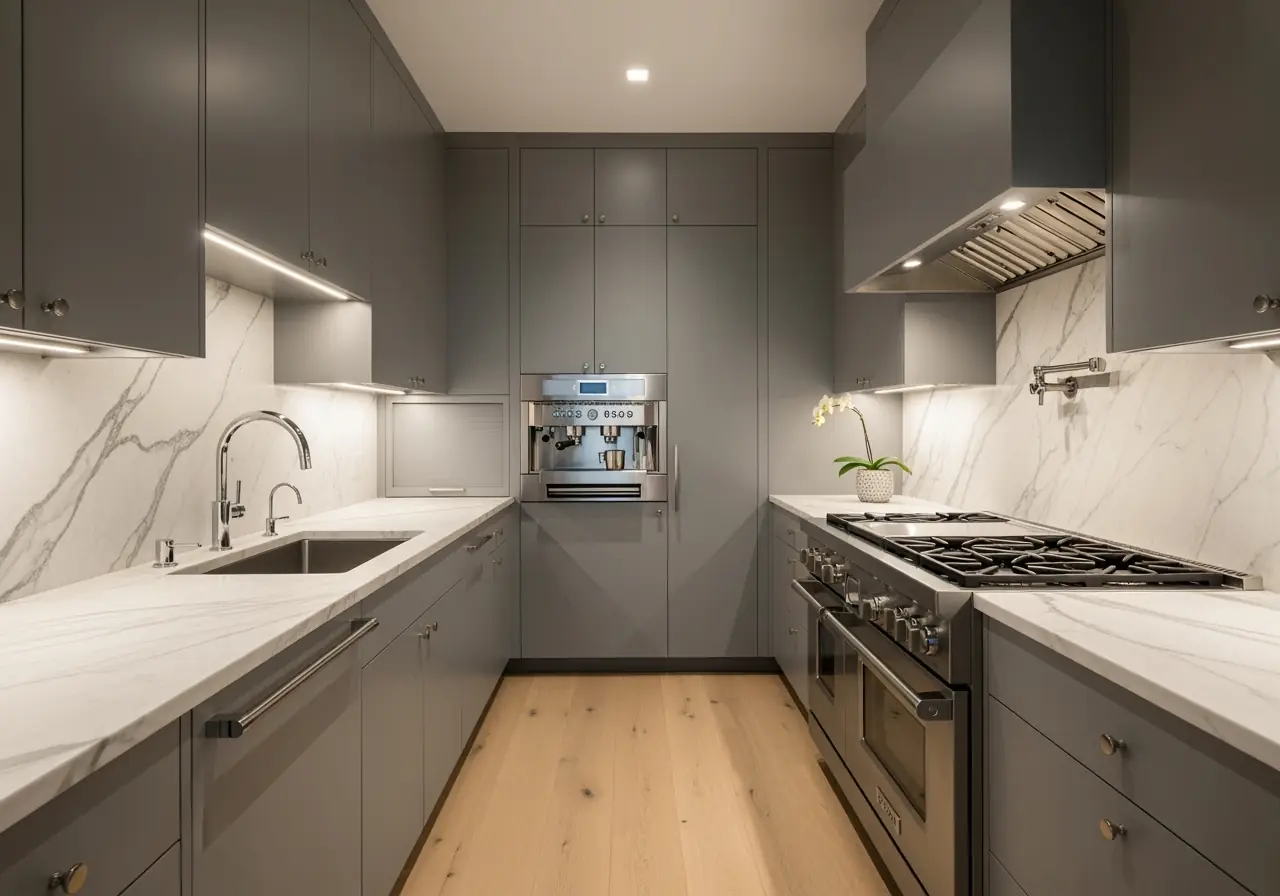
Timeline expectations for a full remodel
Most Manhattan galley kitchen renovations follow this sequence:
- Design and procurement: approximately 30 days
- Protection and demolition: 2-4 days
- Build phase: 3-6 weeks once underway
In total, plan for about six months from initial concept to completion.
Working with a kitchen designer or contractor
Partnering with a full-service design-build firm often yields better results than hiring labor-only contractors. Designers help optimize your galley layout while contractors coordinate the execution. Professional kitchen designers offer invaluable expertise in transforming your vision into reality through detailed renderings and material selection.
Mistakes to avoid in small kitchen renovations
Common pitfalls include underestimating budget requirements (add 15-20% contingency), choosing appliances after cabinetry installation, and neglecting proper clearances between elements. Moreover, avoid following temporary kitchen trends - invest in timeless design that complements your home's architectural character.
Conclusion
Transforming your Manhattan galley kitchen into a luxurious, high-function space begins with smart design, premium materials, and expert execution. The right 4 - 6 foot aisle width ensures comfortable movement, while a well-planned work triangle optimizes efficiency between the sink, stove, and refrigerator. Incorporating luxury elements - such as quartz or marble countertops, custom cabinetry, and layered lighting - elevates both style and functionality. Light, reflective palettes make narrow kitchens feel larger, while smart storage solutions maximize every inch.
With professional guidance from experienced kitchen designers and contractors, your galley kitchen can become a stunning focal point of your home, blending elegance with practicality. Rather than seeing spatial limitations, embrace the opportunity to create a space that enhances daily living and boosts property value. Contact KS Renovation Group today to start designing your dream Manhattan galley kitchen and bring your vision to life with unmatched craftsmanship and attention to detail.
Key Takeaways
Transform your cramped Manhattan galley kitchen into a luxurious, functional space with strategic design choices and smart material selections that maximize both efficiency and style.
• Optimize layout with proper spacing: Maintain 4-6 feet aisle width and position sink, stove, and refrigerator in a work triangle for maximum efficiency and comfort.
• Invest in luxury materials strategically: Quartz countertops, custom cabinetry, and light-colored finishes create visual expansion while adding significant value to your space.
• Layer lighting and use light colors: Under-cabinet LEDs, recessed fixtures, and high LRV paint colors like Pure White make narrow kitchens feel dramatically more spacious.
• Budget realistically for NYC renovations: Standard galley kitchen remodels cost $17,000-$21,000, while luxury upgrades reach $40,000, with 6-month timelines from concept to completion.
• Maximize storage with custom solutions: Floor-to-ceiling cabinets, pull-out pantries, and hidden appliance garages utilize every inch without compromising the streamlined galley aesthetic.
When executed thoughtfully, galley kitchens offer unmatched efficiency for single-cook households while creating a sophisticated culinary environment that enhances both daily living and property value in space-constrained Manhattan apartments.
FAQs
Q1. What is the ideal width for a galley kitchen aisle? The ideal aisle width for a galley kitchen is between 4 to 6 feet. This range provides comfortable movement while maintaining the efficiency that makes galley layouts desirable in compact spaces.
Q2. How can I make my small galley kitchen look more luxurious? To make your galley kitchen look more luxurious, consider using high-end materials like quartz countertops, custom cabinetry, and glass mosaic tile backsplashes. Additionally, strategic lighting and a light color palette can create a more spacious and upscale feel. Incorporating modern kitchen design elements and open shelving can also enhance the luxury aesthetic.
Q3. What's the average cost of renovating a galley kitchen in Manhattan? The cost of renovating a galley kitchen in Manhattan typically ranges from $17,000 to $21,000 for standard upgrades. For high-end finishes and premium appliances, the cost can increase to $25,000 to $40,000.
Q4. How long does a full galley kitchen renovation usually take? A full galley kitchen renovation in Manhattan usually takes about six months from initial concept to completion. This includes approximately 30 days for design and procurement, 2-4 days for demolition, and 3-6 weeks for the build phase.
Q5. What are some smart storage solutions for a galley kitchen? Smart storage solutions for a galley kitchen include custom cabinets with pull-out pantry shelves, extra-deep drawers, and built-in utensil caddies. Additionally, appliance garages, pull-out trash bins, and fold-down countertops can maximize functionality without expanding the kitchen's footprint. Implementing clever kitchen organization techniques and utilizing vertical space can significantly improve storage capacity in a compact galley kitchen.

KS Renovation Blog
Get Inspired
Meaningful information about home remodeling for the true NYC homeowners.
OUr Clients Say
NYC kitchen remodeling Projects and more


